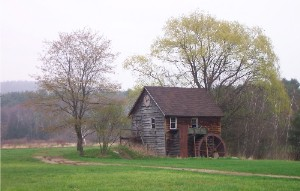
The history of stone walls is almost as complex as the people(s) who built them. To learn about them, chose the size of the bite you want:
IN ONE PARAGRAPH
For a one-paragraph summary:
Abandoned stone walls found in the woods all over New England have a long and fascinating story. Long before their recent re-discovery and appreciation in the early-20th century, the vast majority of stone walls were in the process of falling apart and decomposing within the woodlands of New England. And before that, they were built by early American farm families using stones that heaved up from the subsoil during agricultural activities such as the tillage of crops and the pasturing of livestock. All of this took place long after the stones were buried by natural organic processes, stones that were quarried from rock by the last ice sheet to cover New England and then scattered over the landscape. The ice sheet responsible for this was passing over the hard rocky surface of the heavily fractured continental crust of northeastern North America, which had been created during an earlier episode of mountain building responsible for creating the ancient Appalachian Mountains. In turn, that ancient rock was made of the residues or older rock, which were made from elements gathered during formation of planet Earth and the rest of our solar system. The story of stone walls begins with the Big Bang, and ends with the present moment.
IN TEN SHORT PARAGRAPHS
For a historical sketch in ten easy steps, read the paragraphs below
1 – Making Matter
It is self evident that a stone wall is made of matter, rather than of energy. However, there once was a time — about 13.7 billion years ago — when matter and energy, as well as time and place, were indistinguishable. Only after the first few moments of creation, and in ways we do not yet understand, did matter come into being.
2 – Making Elements
Initially, matter consisted of nothing more than the lightest element hydrogen, with minor helium. Heavier elements were produced later, either in stars undergoing nuclear fusion, or during times when stars exploded, events called supernovae. Elements are the basic building blocks of everything we can touch or hold, whether solid, liquid, or gas. Oxygen, for example, isn’t just something we breathe. It’s also the most common element found in many minerals. Quartz, for example, holds two atoms of oxygen for every one of silicon. Lime, for example, consists of three elements: one atom of calcium, one of carbon, and three of oxygen. All of the elements found in New England walls were present as stellar dust and debris when our present solar system formed, a process which created the earth about 4.6 billion years ago.
3 – Making Rock
A rock is an aggregate of one or more minerals, which are naturally occurring, inorganic, crystalline substances whose composition varies within specified limits. Most of the minerals making up the bedrock in New England were created when older materials such as mud, sand, and lava were transformed by heat and pressure, sometimes to the melting stage. This happened during several prolonged episodes of mountain building that created the Appalachians between 500 million and 300 million years ago. These episodes spanned the interval between the time when animals were first evolving from sea to land to the time when large amphibians and archaic reptiles dominated the land. Almost all of New England’s rock was formed before the dinosaurs and flowering plants came into existence.
4 – Making Stones
Deep in the earth’s crust, the bedrock is an unbroken mass of discrete masses of rock that were welded together within the roots of ancient mountains. Deep down, there were no fractures or voids, and therefore no stones. During the last few tens of million of years, however, and as the weight of eroded rocks was removed, the top mile or so of the of New England’s crust expanded slightly, rupturing into billions of tightly nested fragments. This took place gradually, during an interval when the great apes in east Africa were evolving first into hominids, then later to humans. Beginning about one million years ago, giant ice sheets repeatedly oozed southward from Canada. When they encountered the bumpy bedrock surface of the New England interior, they quarried up countless boulders, crushing most of them into mud and sand. Uncrushed stones were left scattered widely across the landscape, either embedded within the till (ground-up glacial debris), or concentrated at its surface. These are the stones — produced between 150,000 and 15,000 years ago — that would later end up in stone walls.
5 – Burying Stones
When the last ice sheet melted northward it uncovered a landscape that was dusty, rocky and barren. Gradually, plants invaded the surface as rock, dirt, and sand yielded to tundra which later gave way to a boreal parkland, then finally to a continuous forest. Over time, coniferous forest gave way to the largely deciduous forest, the one in which Native Americans lived for millennia, the one encountered by the first Europeans. In the fifteen thousand-year interlude between deglaciation and English settlement, rich forest soils developed on sand and silt, fractionated upward from the till, obscuring many of the stones beneath the surface. European settlers arrived at a time when the stones were most deeply buried.
6 – Harvesting Stones
The subsequent conversion of forest to farm precipitated great changes in the soil. Most important was the gradual loss of the organic mulch and black topsoil, that had previously helped insulate the subsoil from winter’s cold. Loss of the insulating layer coincided with an interval known as the Little Ice Age (1300-1900 AD), during which winters were colder than today. The combination of bare soil, cold climate, and greater exposure enhanced the rate at which stones were heaved upward, out of the soil, by frost . Deep freezing also contributed to the loss of topsoil by erosion, especially during spring, because the rain has more difficulty infiltrating, and therefore had no alternative but to flow on the surface. To at least one generation of farmers, the stones appeared on the land surface like magic.
7 – Scuttling Stones
The accumulation of stones in cleared fields, mowlands, and pastures required that they be removed. In an age before petroleum-powered heavy equipment, this was done either by hand or with the assistance of oxen and draft horses. Stones were seldom hauled much further than necessary, which usually meant the nearest fence line. Elongate piles of stone and primitive tossed walls grew up — almost automatically — as the stone being harvested and scuttled aside, year after year.
8 – Making Walls
Broadly speaking, the cultural prestige of farming in New England and its profitability began to decline after the 1830s following completion of the Erie Canal, construction of large mill-powered factories, and the spread of early railroads. Before the tide turned, however, rural upland farmers experienced several decades of great prosperity, one that coincided with a movement towards scientific farming, a surplus of labor, and rural population growth. During this interval, even as pioneering farmsteads were being created in more remote regions, many of the ragged walls that had accumulated in earlier settlements were rebuilt into more aesthetically pleasing forms, especially by wealthy farmers and early industrialists.
9 – Abandonment
By the 1880s, thousands of rural farms had been abandoned, especially in upland terrain removed from growing industrial cities. Those stone walls not already enveloped by forest were often quarried for the stone they contained for use in bridges, canals, and piers, or crushed for road sub-grade. Walls on remaining working farms were often destroyed to create larger fields or to drain the land. The invention of concrete, the allure of all things urban, and the steadily growing secondary forest rendered abandoned walls into an almost forgotten phenomenon. Meanwhile, the walls tumbled and crusted over with lichens, the trees grew larger, and dryland stone habitats were colonized by a wide array of creatures that would otherwise have no place to live. Walls also kept patches of forest discrete, keeping the woods more diverse.
10 – Reclamation
Beginning in the first decades of the 20th century, and accelerating toward the present, rural farmstead walls have become cultural icons to the origin of America as a nation, as well as a reminder of the slower, simpler life before the modern era. The allure of stone walls, especially old and time-tarnished ones led to their building and reconstruction on many properties, rural properties reclaimed during the last half century. The allure of walls is so great, however, that they are increasingly being pulled apart and shipped to make newer walls in wealthier places. In the process, habitat is being lost, and the authenticity of place is being compromised. Efforts are now being made to investigate and preserve old stone walls.
IN ONE BOOK
For the same history expanded into ten chapters, I suggest the narrative, Stone by Stone: The Magnificent History in New England’s Stone Walls. (Walker & Company, 2002).
